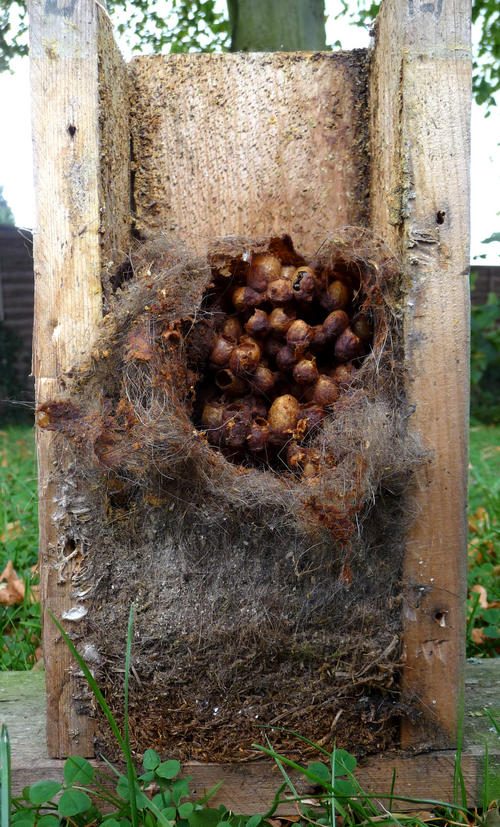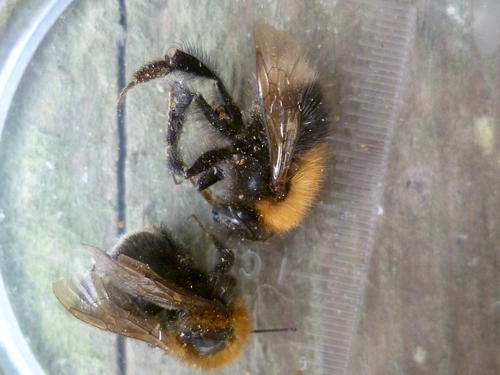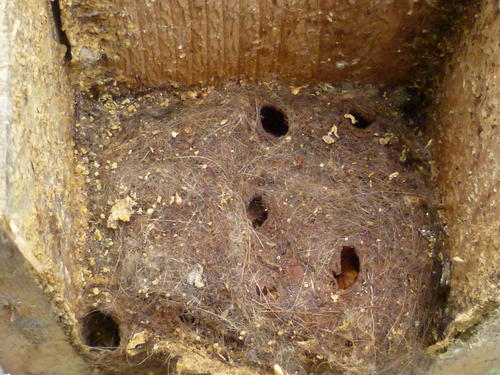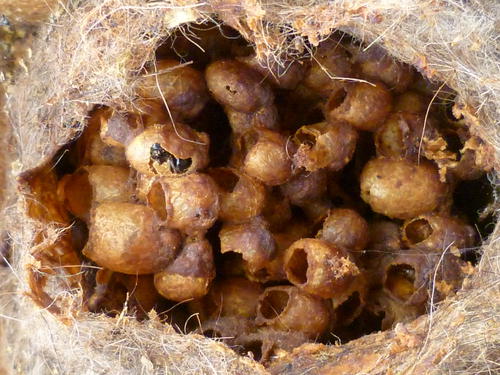A summary of recording events in 2011
Mark E Turner
Lily Beetles Lilioceris lilii in an Evesham garden, (SP044436), continued.
In the wake of Lily Beetle reports in recent issues of Worcestershire Record including my own contribution (Turner 2010a), I felt it was only right that I did a follow-up since the ‘Red Devils’ continue to emerge unabated.
Despite the winter of 2010-2011 being particularly long and harsh, Lily Beetles appeared undefeated with adults showing on garden border lily plants much earlier than previously noticed with the first one on a warm (23ºC) 6th April. Does nothing deter these garden pests? The following five days continued to be warm and dry when a further four adults emerged including a mating pair on 11th April. One more adult beetle appeared on 12th April ending an early run of pestilence. However, just when you thought it was safe, three more adults emerged in sheer defiance on a warm 16th April, another two on 19th April, and three on 23rd April. A further five adults appeared on 5th, 6th, and 8th May: that’s 19 beetles from 10 stems of lilies, but including one on a Snake’s head Fritillary seed head nearby.
Considering the tiny size of the garden and the very few plants currently growing in the border (May 2011), we would certainly have a patch devastated in next to no time were it not for our vigilance. Here follows further finds in brief:
4th June 2011 at 17.30 hrs, a mating pair, a single adult and two larvae from three lily stems. Another larva found on 6th June, 16 larvae and an adult on 24th June, last larva and adult on 27th June. Lily leaves were black with larval mess and eaten ragged.
Scarlet tiger moth Callimorpha dominula
Also following my report for this species (Turner 2010a) in Evesham gardens (SP044436), the voracious larva appeared in numbers once again on a variety of food plants at the overgrown weedy edges of a town terrace lane in the Bengeworth area. By the 9th April many had grown to a good size and were wandering up house walls and garden fences. The last larva I found appeared on our water butt during the afternoon of 10th May.
The larva has black and yellow stripes down its length which are punctuated by white dots. The small head is shiny black. The larval cycle lasts from August to May and the flight season from the end of May to early July.
Unfortunately mice abound in this area and Brown Rats are frequent, but despite the larva having warning colours like the moth, I imagine many chrysalises that formed in the vegetation and leaf litter were predated by the rodents.
Slightly earlier than expected (this spring has been extraordinary), I found my first Scarlet Tiger Moth on 17th May 2011, but sadly had been squashed on the pavement in Lime Street, Evesham, in the general area where my reports on them have been focused. Compare this to 30th May 2010. In the days that followed I was horrified to see that the Moth’s breeding grounds in our back lane had been sprayed with weed-killer by the Council and wondered what effect this would have on emerging adults.
My worst fears were laid to rest at 18.50 hrs on 31st May 2011. My wife Christine noticed the first one fluttering around the end of the house behind ours at gutter level. On closer inspection a second moth was at rest close-by, just below the rafters. The remarkable point being this is just one day later than last year for the emergence. This beautiful bright red gem seemed to flash in the early evening sun-light; it was a joy to behold. Forty-five minutes later the first moth on its maiden flight came to rest on the gutter channel no more than a foot from its reposing companion and this is where they remained until the following morning. Here follows brief notes on further observations.
1st June 2011 at 12.15 hrs, next one was fluttering next to traffic in Port Street, Evesham. 2nd June and two sightings during the evening. From now on Tigers were seen daily in the general area of Bengeworth, Evesham, and I came across many casualties squashed on pavements. Incredibly I found one emerging from limp and dying vegetation following the weed killer spraying and I saved one from certain death as it lay on its back entangled in spider’s webbing.
13th June at 17.00 hrs was notable for several Scarlet Tigers emerging in our garden. These included two mating pairs and evidently on close inspection they don’t wait for the wings to fully dry in readiness for flight if a willing partner is close by for the natural process to take place. Such is the importance of procreation.
Common Bee-fly Bombylius major
I found my first ones of the year at Broadway Gravel Pit LNR (SP087379) on 7th April visiting Ground Ivy flowers. A little later three were hovering well above head height and occasionally engaged in chases. At 12.00 hrs we observed two Bee-flies mating at ground level; one was at rest on the edge of a leaf whilst its attached mate hovered in mid-air. They took flight and continued to mate on the wing.
At least two were present in our Evesham garden (SP044436) attracted to Cowslips and blue Forget-me-not flowers on 9th April.
Small Copper Lycaena phlaeus
This one took me by surprise, a diminutive beauty on Vale of Evesham market garden land off Wickhamford Lane (SP058426) on 12th April which I temporarily disturbed from sunning on the bare soil. It re-alighted quickly on a spent cartridge case.
My next example of this mini gem appeared on 4th May at Broadway Gravel Pit Local Nature Reserve (SP087379), again sunning and resting on the ground in the small car park.
Mother Shipton Moth Callistege mi.
2nd June 2011, SP107379, Broadway.
Fan-foot Moth Zandognatha tarsipennalis.
13th June 2011 SP044436, Evesham.
Buff Ermine (male), Spilosoma luteum.
17th June 2011, SP044436, Evesham.
Riband Wave, Idaea aversata.
27th June 2011, SP044436, Evesham.
Uncommon tern of events. Part 2
Like a bolt from the blue at 13.00 hrs on a sunny 21st May 2011 whilst my wife and I stood on our back patio, we just happened to look up to see the very distinctive shape of a returning Common Tern Sterna hirundo in an apparent stoop over our neighbourhood in Bengeworth, Evesham. It gave out a sharp KEK call as it passed heading north to northeast parallel with the River Avon.
This immediately recalled events which I reported before (Turner 2010b). A quick check at the weir nearby as per last summer’s venue unfortunately drew a blank; we had been truly lucky with our view from home.
The next Common Tern to appear was on 19th June with a single bird flying down river seen from Evesham’s Workman Gardens at 14.00 hrs, but more surprisingly two calling birds were active again at the weir during the same week.
Tree Bumblebee Bombus hypnorum at Broadway Gravel Pit LNR (SP087379)
29th May 2011
Bumblebees were first noted entering the base of a large Willow through a narrow crevice. There was a curious pile of wood chippings below the nest entrance. Identification had not yet been confirmed but I had my suspicions.
4th June 2011
This was a follow up session to look closer at what now appears to be a scarce (but increasing in range) species – the Tree Bumblebee - nesting in the base of the willow and also in a nearby open-fronted nest box.
Our insects certainly matched descriptions which I gleaned from the Worcestershire Record having gingery brown thorax hairs, black abdomen and white tail.
At the end of July there were no bees active around the nest box so I removed it for closer inspection (Figs. 1-4).
17th September 2011
Confirmation of identity regarding our nest box and willow tree nesting bees as the rare Tree Bumblebee. Bombus hypnorum, came when two dead specimens and the nest box nest were shown to Harry Green, John Meiklejohn and Geoff Trevis.
[Interestingly the nest of Bombus hypnorum in the bird nest box appears to be constructed on top a bird’s nest. Ed.]
References
Turner, M. E. 2010a. Red Devils and Dancing Tigers (Lily Beetles and Scarlet Tigers). Worcestershire Record 29:22.
Turner, M. E. 2010b. An uncommon tern of events (Common Terns Sterna hirundo) in Evesham. Worcestershire Record 29:41-42.
Images
Fig. 1. Bombus hypnorum nest in bird nest box. Harry Green
Fig. 2. Dead Bombus hypnorum found with nest. Mark E Turner.
Fig. 3. Undamaged Bombus hypnorum nest in bird box. Mark E Turner
Fig. 4. Opened Bombus hypnorum nest in bird nest box. Mark E Turner



